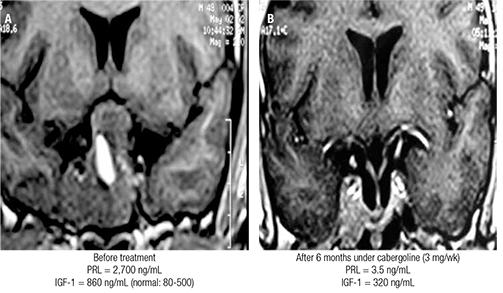The definition of the etiology of hyperprolactinemia often represents a great challenge and an accurate diagnosis is paramount before treatment. Although prolactin levels > 200-250 ng/mL are highly suggestive of prolactinomas, they can occasionally be found in other conditions. Moreover, as much as 25% of patients with microprolactinomas may present prolactin levels < 100 ng/mL, which are found in most patients with pseudoprolactinomas, drug-induced hyperprolactinemia, or systemic diseases. On the other hand, some conditions may lead to falsely low PRL levels, particularly the so-called hook effect, that is an assay artifact caused by an extremely high level of PRL, and can be confirmed by repeating assay after a 1:100 serum sample dilution. The hook effect must be considered in all patients with large pituitary adenomas and PRL levels within the normal range or only modestly elevated (e.g., < 200 ng/mL). An overlooked hook effect may lead to incorrect diagnosis and unnecessary surgical intervention in patients with prolactinomas. Another important challenge is macroprolactinemia, a common finding that needs to be identified, as it usually requires no treatment. Although most macroprolactinemic patients are asymptomatic, many of them may present galactorrhea or menstrual disorders, as well as neuroradiological abnormalities, due to the concomitance of other diseases. Finally, physicians should be aware that pituitary incidentalomas are found in at least 10% of adult population. Arq Bras Endocrinol Metab. 2014;58(1):9-22
Hyperprolactinemia; diagnostic pitfalls; hook effect; macroprolactinemia; pituitary incidentalomas










